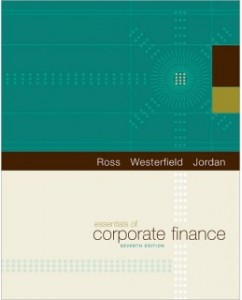Instant download Test Bank for Essentials of Corporate Finance, 7th Edition: Stephen A. Ross pdf docx epub after payment.

Product details:
- ISBN-10 : 0073382469
- ISBN-13 : 978-0073382463
- Author: Stephen Ross; Bradford D. Jordan; Randoloph W. Westerfield
Essentials of Corporate Finance, 7th edition by Ross, Westerfield, and Jordan is written to convey the most important concepts and principles of corporate finance at a level that is approachable for a wide audience. The authors retain their modern approach to finance, but have distilled the subject down to the essential topics in 18 chapters. They believe that understanding the “why” is just as important, if not more so, than understanding the “how,” especially in an introductory course. Three basic themes emerge as their central focus:
1. An emphasis on intuition–separate and explain the principles at work on a common sense, intuitive level before launching into specifics. Underlying ideas are discussed first in general terms, then followed by specific examples that illustrate in more concrete terms how a financial manager might proceed in a given situation.
2. A unified valuation approach–Net Present Value is treated as the basic concept underlying corporate finance. Every subject the authors cover is firmly rooted in valuation, and care is taken to explain how decisions have valuation effects.
3. A managerial focus–Students learn that financial management concerns management. The role of financial manager as decision maker is emphasised and they stress the need for managerial input and judgment.
Table of contents:
PART ONE OVERVIEW OF FINANCIAL MANAGEMENT
Introduction to Financial Management
Finance: A Quick Look
2(2)
The Four Basic Areas
2(1)
Corporate Finance
2(1)
Investments
2(1)
Financial Institutions
3(1)
International Finance
3(1)
Why Study Finance?
3(1)
Marketing and Finance
3(1)
Accounting and Finance
3(1)
Management and Finance
4(1)
You and Finance
4(1)
Business Finance and the Financial Manager
4(3)
What Is Business Finance?
4(1)
The Financial Manager
5(1)
Financial Management Decisions
5(1)
Capital Budgeting
5(1)
Capital Structure
5(1)
Working Capital Management
6(1)
Conclusion
6(1)
Forms of Business Organization
7(3)
Sole Proprietorship
7(1)
Partnership
7(1)
Corporation
8(1)
A Corporation by Another Name
9(1)
The Goal of Financial Management
10(2)
Profit Maximization
10(1)
The Goal of Financial Management in a Corporation
10(1)
A More General Financial Management Goal
11(1)
Sarbanes-Oxley Act
12(1)
The Agency Problem and Control of the Corporation
12(3)
Agency Relationships
12(1)
Management Goals
13(1)
Do Managers Act in the Stockholders’ Interests?
13(1)
Managerial Compensation
13(1)
Control of the Firm
14(1)
Conclusion
15(1)
Stakeholders
15(1)
Financial Markets and the Corporation
15(3)
Cash Flows to and from the Firm
16(1)
Primary versus Secondary Markets
16(1)
Primary Markets
17(1)
Secondary Markets
17(1)
Summary and Conclusions
18(1)
Critical Thinking and Concepts Review
19(1)
What’s on the Web?
20(1)
Chapter Case: The McGee Cake Company
21(2)
PART TWO UNDERSTANDING FINANCIAL STATEMENTS AND CASH FLOW
Financial Statements, Taxes, and Cash Flow
The Balance Sheet
23(4)
Assets: The Left-Hand Side
23(1)
Liabilities and Owners’ Equity: The Right-Hand Side
23(1)
Net Working Capital
24(1)
Liquidity
25(1)
Debt versus Equity
26(1)
Market Value versus Book Value
26(1)
The Income Statement
27(4)
GAAP and the Income Statement
28(1)
Noncash Items
29(1)
Time and Costs
29(1)
Earnings Management
30(1)
Taxes
31(3)
Corporate Tax Rates
32(1)
Average versus Marginal Tax Rates
32(2)
Cash Flow
34(7)
Cash Flow from Assets
34(1)
Operating Cash Flow
34(1)
Capital Spending
35(1)
Change in Net Working Capital
36(1)
Conclusion
36(1)
A Note on “Free” Cash Flow
36(1)
Cash Flow to Creditors and Stockholders
36(1)
Cash Flow to Creditors
37(1)
Cash Flow to Stockholders
37(1)
Conclusion
37(2)
An Example: Cash Flows for Dole Cola
39(1)
Operating Cash Flow
39(1)
Net Capital Spending
39(1)
Change in NWC and Cash Flow from Assets
39(1)
Cash Flow to Creditors and Stockholders
40(1)
Summary and Conclusions
41(1)
Chapter Review and Self-Test Problem
41(1)
Answer to Chapter Review and Self-Test Problem
42(2)
Critical Thinking and Concepts Review
44(1)
Questions and Problems
45(3)
What’s on the Web?
48(2)
Chapter Case: Cash Flows and Financial Statements at Sunset Boards, Inc.
50(2)
Working with Financial Statements
Standardized Financial Statements
52(3)
Common-Size Balance Sheets
53(1)
Common-Size Income Statements
54(1)
Ratio Analysis
55(9)
Short-Term Solvency, or Liquidity, Measures
56(1)
Current Ratio
56(1)
Quick (or Acid-Test) Ratio
57(1)
Cash Ratio
57(1)
Long-Term Solvency Measures
58(1)
Total Debt Ratio
58(1)
Times Interest Earned
58(1)
Cash Coverage
58(1)
Asset Management, or Turnover, Measures
59(1)
Inventory Turnover and Days’ Sales in Inventory
59(1)
Recivables Turnover and Days’ Sales in Receivables
60(1)
Total Asset Turnover
61(1)
Profitability Measures
61(1)
Profit Margin
61(1)
Return on Assets
62(1)
Return on Equity
62(1)
Market Value Measures
62(1)
Price-Earnings Ratio
62(1)
Price-Sales Ratio
63(1)
Market-to-Book Ratio
63(1)
The Du Pont Identity
64(4)
An Expanded Du Pont Analysis
66(2)
Internal and Sustainable Growth
68(4)
Dividend Payout and Earnings Retention
68(1)
ROA, ROE, and Growth
69(1)
The Internal Growth Rate
69(1)
The Sustainable Growth Rate
70(1)
Determinants of Growth
70(1)
A Note of Sustainable Growth Rate Calculations
71(1)
Using Financial Statement Information
72(8)
Why Evaluate Financial Statements?
72(1)
Internal Uses
72(1)
External Uses
73(1)
Choosing a Benchmark
73(1)
Time-Trend Analysis
73(1)
Peer Group Analysis
73(5)
Problems with Financial Statement Analysis
78(2)
Summary and conclusions
80(1)
Chapter Review and Self-Test Problems
80(2)
Answers to Chapter Review and Self-Test Problems
82(1)
Critical Thinking and Concepts Review
83(2)
Questions and Problems
85(6)
What’s on the Web?
91(2)
Chapter Case: Ratios and Financial Planning at S&S Air, Inc.
93(3)
PART THREE VALUATION OF FUTURE CASH FLOWS
Introduction to Valuation: The Time Value of Money
Future Value and Compounding
96(7)
Investing for a Single Period
96(1)
Investing for More Than One Period
96(7)
People also search:
Essentials of Corporate Finance
Essentials of Corporate Finance Stephen A. Ross
Essentials of Corporate Finance Stephen A. Ross 7th
Essentials of Corporate Finance Stephen A. Ross 7th Test Bank
Test Bank for Essentials of Corporate Finance, 7th Edition: Stephen A. Ross Download





